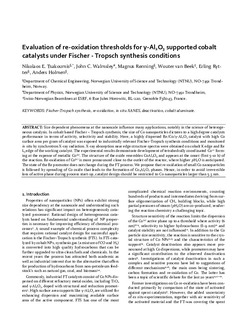Evaluation of Reoxidation Thresholds for γ-Al2O3-Supported Cobalt Catalysts under Fischer - Tropsch Synthesis Conditions
Tsakoumis, Nikolaos; Walmsley, John; Rønning, Magnus; van Beek, Wouter; Rytter, Erling; Holmen, Anders
Journal article, Peer reviewed
Accepted version
Permanent lenke
http://hdl.handle.net/11250/2460802Utgivelsesdato
2017Metadata
Vis full innførselSamlinger
- Institutt for fysikk [2685]
- Institutt for kjemisk prosessteknologi [1775]
- Publikasjoner fra CRIStin - NTNU [37963]
Originalversjon
Journal of the American Chemical Society. 2017, 139 (10), 3706-3715. 10.1021/jacs.6b11872Sammendrag
Size-dependent phenomena at the nanoscale influence many applications, notably in the science of heterogeneous catalysis. In cobalt-based Fischer–Tropsch synthesis (FTS), the size of Co nanoparticles (NPs) dictates to a high degree catalyst’s performance in terms of activity, selectivity, and stability. Here, a highly dispersed Re/Co/γ-Al2O3 catalyst with high Co surface area per gram of catalyst was exposed to industrially relevant FTS conditions and monitored in situ by synchrotron X-ray radiation. X-ray absorption near-edge structure spectra were obtained on the cobalt K edge and Re L3 edge of the working catalyst. The experimental results demonstrate development of tetrahedrally coordinated Co2+ forming at the expense of metallic Co(0). The structure of the oxide resembles CoAl2O4 and appears at the onset (first 5–10 h) of the reaction. Reoxidation of Co(0) is more pronounced close to the outlet of the reactor, where higher pH2O is anticipated. The state of the Re promoter does not change during the FT process. We propose that reoxidation of small Co NPs is followed by spreading of Co oxide that leads to the formation of CoxAlyOz phases. Hence, in order to avoid an irreversible loss of the active phase during process start-up, catalyst design should be restricted to Co NPs larger than 5.3 nm.
